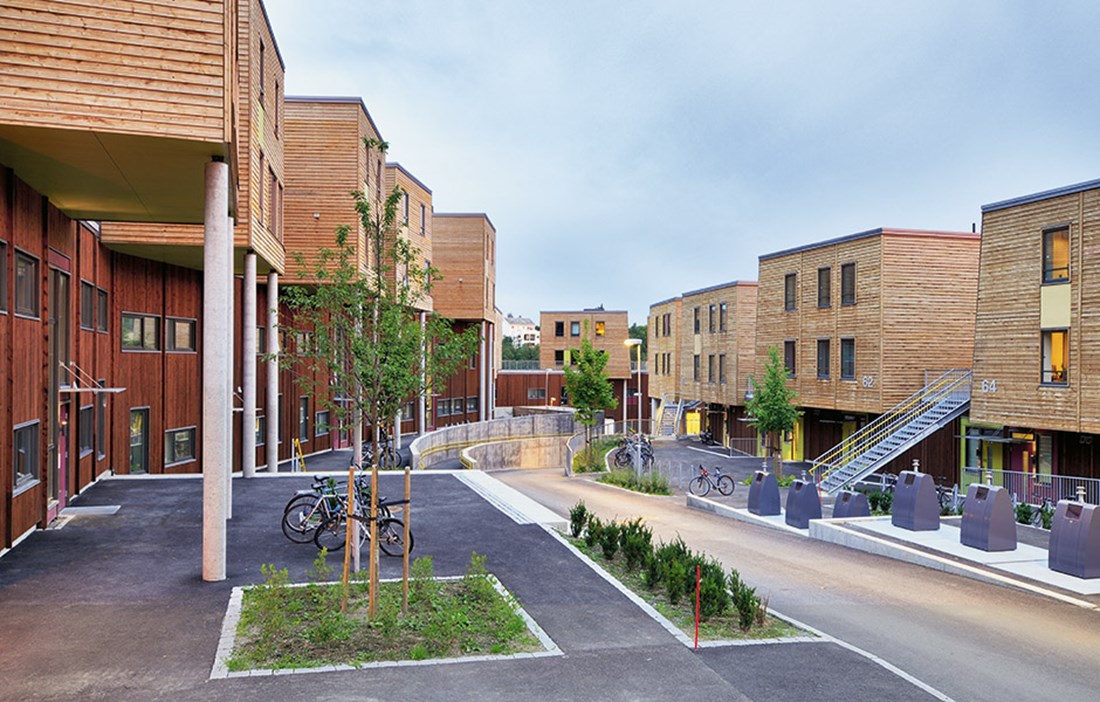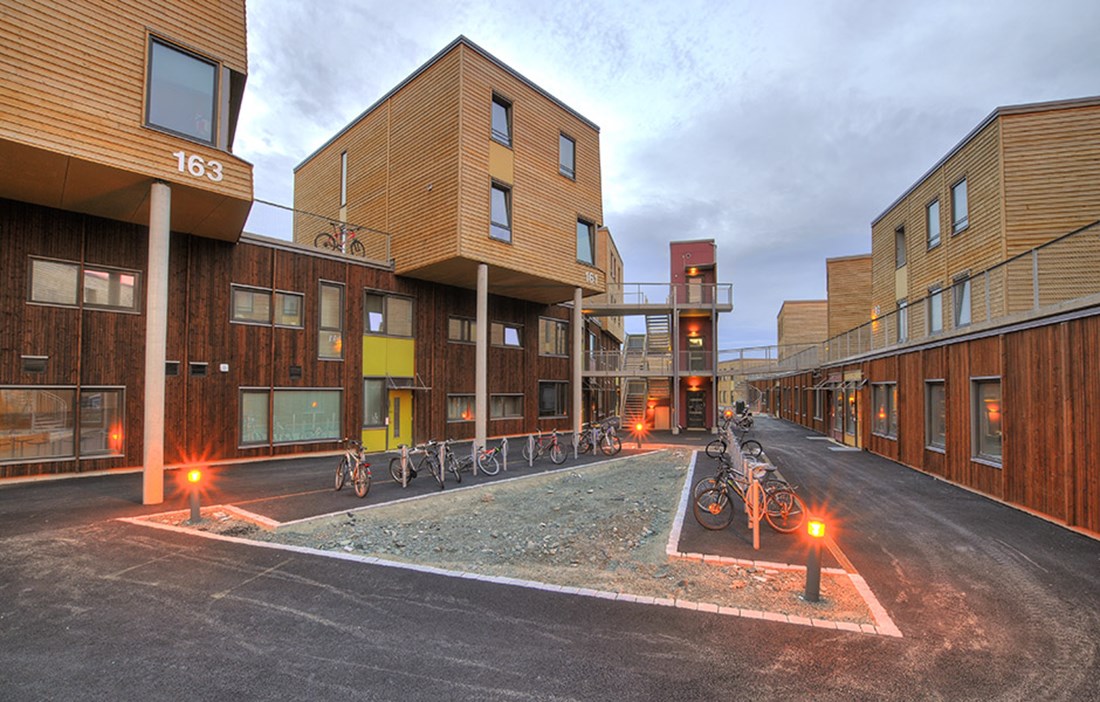TRONDHEIM HAS LONG had a rather frumpy reputation in Norway. However, that is gradually changing and now Norway’s third-largest city is teeming with hip cafés and bars. Perhaps the most prominent feature of the coastal city, which was actually Norway’s first capital, is all the beautiful old timber buildings. Between the impressive wooden villas on large plots and the quayside warehouses painted in soft colours, there are echoes of a time gone by – of Ibsen, Munch and Grieg.
What has really injected life into Trondheim is its students. This is one of Norway’s very biggest university towns, where 30,000 of the 200,000 inhabitants are students. Student life has taken the old trading port from frumpy to trendy and modern – the city was the first in Europe to have a Wi-Fi network across the whole city centre. When the old Berg student village from 1956, one of several pockets of student accommodation in Trondheim, was set to be demolished and replaced with one double the size, the bar was therefore set extremely high. The new student accommodation had to be both eco-friendly and modern, and equipped with all the latest technology. An architectural competition was announced and Skibnes Arkitekter submitted the winning entry. The result is a complex of studio apartments, apartments for two and larger shared residences with capacity for 644 students in total.
HOWEVER, THE CONDITIONS for building were not the easiest. If, as you drive past down on Dybdahlsveg, one of Trondheim’s main roads, you look up at the hill that Berg student village occupies you’ll understand why. The site sits on a south-facing slope with a drop of over 20 metres towards the west. The housing complex therefore had to be adapted to the terrain, so Skibnes Arkitekter created a unique solution with a distinct two-part design: solid concrete-based apartments at ground level with separate small wooden cubes above. One of the ideas behind the cubes was that they would be seen as individual ‘houses’, so the students would have a greater sense of ownership. The apartments circle down the hill, following its contours, giving rise to the nickname ‘the Snake’.
“The special thing about Berg student village is the Snake, a design that solves several problems. The concrete Snake acts as a support for the wooden cubes, which are made from prefabricated box units. The design allowed us to build small-scale accommodation above the apartments, make access easier and also create wonderful, intimate outdoor spaces around the cubes,” explains architect Svein Skibnes of Skibnes Arkitekter.
However, the terrain threw up more challenges than just the slope. Large parts of the hill were covered in quick clay, a kind of clay that can cause landslides on sloping ground. The focus was therefore on positioning the student accommodation to avoid the quick clay, working in close collaboration with geotechnical engineers throughout the process. The load on the top of the hill was also reduced by excavating around 20,000 m³ of clay, which was placed at the bottom of the slope instead. When construction began, the work then started from the bottom up, in order to maintain pressure on the clay.
Another challenge was the rather tricky logistics. Since the site is located in an established residential area, only one route was used to access the site. With limited space due to parallel planning and building work, queues and delays could easily occur. Deliveries to the construction site were therefore planned on a monthly basis, to save time and space.
The apartments in the Snake are built of concrete in order to support the weight of the wooden cubes on their roof. The facade of the Snake is then clad in Royal impregnated pine, where the moisture in the wood is replaced with oil to create a highly durable material. Brown pigment was added in the impregnation process for the Snake’s facade, in contrast to the cubes, which are a more natural, lighter colour. This was done for the same reason that the pine cladding was laid vertically on the Snake and horizontally on the cubes – to reinforce the impression of the ‘heavy’ base in relation to the ‘light’ cubes.
The cubes are two-storey buildings of 100 m² per storey, with each level made up of four prefabricated box units. One cube took two days to complete, including finished interiors and exterior. The cubes are made entirely of wood: external walls, roof, floor and internal walls. The actual structure of the cubes is made from spruce timber with mineral wool as insulation. All the timber is locally sourced from forests in mid-Norway.
The area around Berg student village is dotted with numerous old wooden villas from the 1950s and one of the conditions for the development was that the student accommodation should merge into its surroundings.
“Wood seems like an obvious choice when you examine what the surrounding housing stock looks like. It is also attractive, sustainable, requires little maintenance and is eco-friendly. What’s more, it provides a good indoor climate,” states Svein Skibnes.
USING WOOD TO such a large extent does, however, bring certain challenges, including sound insulation – something that can be particularly important in student accommodation where you might have a booming stereo on one side of the wall and a revising student on the other. By fitting double walls and ceilings between the apartments, it was possible to minimise the resonance frequency. Another key factor for safe accommodation is a fireproof building.
“The client did not want sprinklers, in part due to the cost implications. Instead, we resolved the fire safety issue through close partnership with fire safety officers, where we focused on the distance between the buildings’ windows, both vertically and horizontally, since the greatest fire risk is that fire spreads via the windows. By checking the distances, we’ve managed to meet the stringent Norwegian regulations on fire safety,” explains Svein Skibnes.
When it comes to designing buildings that resist moisture and handle a harsh climate, Norway has plenty of expertise.
“We have an excellent tradition of producing building elements that stand up to rain, wind and snow. That knowledge is something we can draw on when working with more non-traditional architecture like this,” says Svein Skibnes.
Special super-insulated roofs were manufactured for the student accommodation, based on Skibnes Arkitekter’s own in-house design. The roof comprises hard mineral wool or polystyrene layered on top of the wood or concrete structure, covered by a membrane. Another solution for the cold climate is to use internal downpipes. This keeps the downpipes warm so that the water does not freeze on its way down to street level.
Environmental considerations were always top of mind on this project, right from the demolition of the old student village. 95 percent of the demolition waste was sorted and much of it was recovered. The client, student welfare organisation SiT, also placed demands on the project that went far beyond the standard regulations that exist in Norway. They wanted Berg student village to be a showcase project for energy efficiency.
The starting point was to follow the Norwegian regulations for energy efficiency from 2007 – tek 07. Over the course of the project, however, even better solutions were found and the design was updated to become a mix of passive houses and low-energy buildings. The materials were carefully chosen to make construction cost-effective, energy-efficient and eco-friendly – while at the same time maintaining high architectural quality. Innovative use of wood in combination with other materials was a key part of this, and also went hand in hand with Trondheim’s drive to become a modern ‘City of Wood’.
INSULATION WAS ESSENTIAL to retain heat in the buildings, so all the wooden structures have an average of 45 cm of mineral wool in the roof and 35 cm in the walls. The windows and doors have a thermal transmittance of less than 0.8 W/m2. Pressure tests have shown that the cubes have an air change rate of 0.28 litres per second per square metre, which is much better than the 0.8 specified in the contract. The student accommodation uses district heating to heat the tapwater and the laundry rooms are equipped with automatic dosing of eco-friendly detergent. With all its energy efficiency initiatives, Berg student village has become a showcase project for Enova, a Norwegian state company that promotes a move towards eco-friendly energy use and energy production in Norway. SiT was also awarded the municipality of Trondheim’s energy prize 2012 for the construction of Berg student village. The jury statement read: “SiT is a role model for other developers and has succeeded in its ambitious environmental and energy drive. They are building to standards that exceed the current technical requirements.”
Environmental awareness has been a common thread throughout the project. However, the architects want to stress that a great deal of work has also gone into building quality accommodation.
“I don’t think the energy efficiencies affect students’ everyday lives, except that their energy costs are lower. But for us there is a major challenge, when it comes to passive houses and low-energy buildings, in being able to build proper windows and get enough daylight into the homes. We don’t build buildings to save energy, but to provide people with great environments in which to live. Daylight is fundamental to all life on Earth, and humans are no exception,” says Svein Skibnes.
The project for the new Berg student village began in 2007 and the last wood panel was fitted in January 2011. Skibnes Arkitekter managed to meet the city’s expectations for good student accommodation, close to the city centre, the university and public transport. Trondheim’s dream of continuing to be one of the leading university towns in Norway remains very much alive – just like their desire to be a modern City of Wood.
“We’re proud of the results. We think we’ve succeeded in creating high quality student accommodation with great outdoor spaces. Berg student village is like its own little community within the city,” concludes Svein Skibnes.
Text Erik Bredhe























